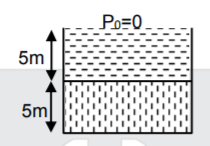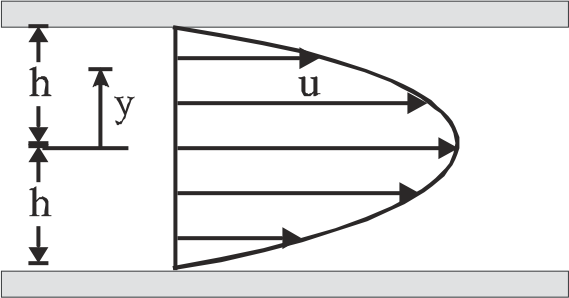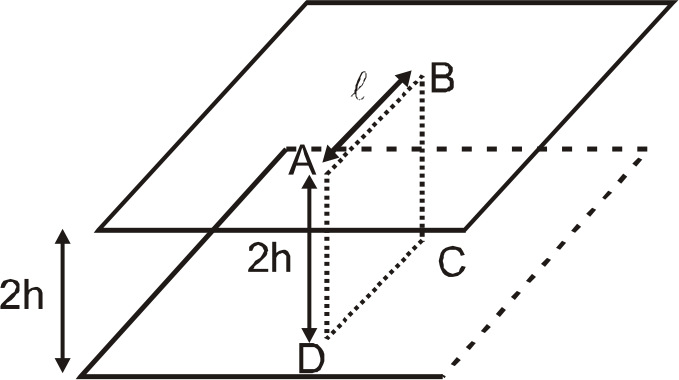A liquid having coefficient of viscosity 0.02 decapoise is filled in a container of cross-sectional area 20 m^2 viscous drag between two adjacent layers in flowing is 1 N, then velocity gradient is
2.0s−1
2.5s−1
3.0s−1
3.5s−1
To solve the problem, we need to find the velocity gradient (dv/dx) given the viscosity, the area, and the viscous drag force.
1. Identify the Given Values:
- Coefficient of viscosity (η) = 0.02 decapoise
- Viscous drag force (F) = 1 N
- Cross-sectional area (A) = 20 m²
2. Convert Viscosity to SI Units:
- 1 decapoise = 0.1 Pa·s
- Therefore, η = 0.02 decapoise = 0.02 × 0.1 Pa·s = 0.002 Pa·s
3. Use the Formula for Viscous Force:
The formula for viscous force between two layers of fluid is given by:
F=η⋅A⋅dvdx
Rearranging this formula to find the velocity gradient (dv/dx):
dvdx=Fη⋅A
4. Substitute the Known Values:
Now, substituting the values we have:
dvdx=1N0.002Pa⋅s⋅20m2
5. Calculate the Denominator:
- Calculate η × A:
0.002Pa⋅s⋅20m2=0.04Pa⋅s⋅m2
6. Calculate the Velocity Gradient:
Now, substitute this back into the equation:
dvdx=1N0.04Pa⋅s⋅m2=25s−1
Final Answer:
The velocity gradient (dv/dx) is 25 s⁻¹.
- Coefficient of viscosity (η) = 0.02 decapoise
- Viscous drag force (F) = 1 N
- Cross-sectional area (A) = 20 m²
- 1 decapoise = 0.1 Pa·s
- Therefore, η = 0.02 decapoise = 0.02 × 0.1 Pa·s = 0.002 Pa·s
The formula for viscous force between two layers of fluid is given by:
F=η⋅A⋅dvdx
Rearranging this formula to find the velocity gradient (dv/dx):
dvdx=Fη⋅A
Now, substituting the values we have:
dvdx=1N0.002Pa⋅s⋅20m2
- Calculate η × A:
0.002Pa⋅s⋅20m2=0.04Pa⋅s⋅m2
Now, substitute this back into the equation:
dvdx=1N0.04Pa⋅s⋅m2=25s−1
The velocity gradient (dv/dx) is 25 s⁻¹.
Similar Questions
A current 0.5 amperes flows in a conductor of cross-sectional area of 10−2m2. If the electron density is 0.3⋅1028m−3 , then the drift velocity of free electrons is
View SolutionA liquid whose coefficient of viscosity is η flows on a horizontal surface. Let dx represent the vertical distance between two layers of liquid and dv represent the difference in the velocities of the two layers. Then the quantity η(dv/dx) has the same dimensions as:
View SolutionA liquid of density 103kgm3 and coefficient of viscosity 8 xx10^(-2) decapoise is flowing in a tube of radius 2 cm with speed 2 m/s. The. Reynold’s number is
View SolutionWhen a viscous liquid flows , adjacent layers oppose their relative motion by applying a viscous force given by
F=−ηAdvdz
where , eta = coefficient of viscosity ,
A = surface area of adjacent layers in contact ,
dvdz = velocity gradient
Now , a viscous liquid having coefficient of viscosity η is flowing through a fixed tube of length l and radius R under a pressure difference P between the two ends of the tube . Now consider a cylindrical vloume of liquid of radius r . Due to steady flow , net force on the liquid in cylindrical volume should be zero .
−η2πrldvdr=Pπr2
−∫0v,dv=P2ηl∫Rτrdr(∵ layer in contact with the tube is stationary )
v=v0(1−r2R2) , where v0=PR24nl
∴ Q=πPR48stal
This is called Poisecuille's equation .

The velocity of flow of liquid at r = R/2 is
View SolutionWhen a viscous liquid flows , adjacent layers oppose their relative motion by applying a viscous force given by
F=−ηAdvdz
where , ete = coefficient of viscosity ,
A = surface area of adjacent layers in contact ,
dvdz = velocity gradient
Now , a viscous liquid having coefficient of viscosity η is flowing through a fixed tube of length l and radius R under a pressure difference P between the two ends of the tube . Now consider a cylindrical vloume of liquid of radius r . Due to steady flow , net force on the liquid in cylindrical volume should be zero .
−η2πrldvdr=Pπr2
−∫0v,dv=P2ηl∫Rτrdr(∵ layer in contact with the tube is stationary )
v=v0(1−r2R2), where v0=PR24nl
∴ Q=πPR48ηL
This is called Poisecuille's equation .

The viscous force on the cylindrical volume of the liquid varies as
View SolutionWhen a viscous liquid flows , adjacent layers oppose their relative motion by applying a viscous force given by
F=−ηAdvdz
where , ete = coefficient of viscosity ,
A = surface area of adjacent layers in contact ,
dvdz = velocity gradient
Now , a viscous liquid having coefficient of viscosity η is flowing through a fixed tube of length l and radius R under a pressure difference P between the two ends of the tube . Now consider a cylindrical vloume of liquid of radius r . Due to steady flow , net force on the liquid in cylindrical vloume should be zero .
−η2πrldvdr=Pπr2
−∫0v,dv=P2ηl∫Rτrdr(∵ layer in contact with the tube is stationary )
v=v0(1−r2R2), where v0=PR24nl
∴ Q=πPR48stal

This is called Poisecuille's equation .
The volume of the liquid flowing per sec across the cross - section of the tube is .
View SolutionTwo liquid columns of same height 5m and densities ρ and 2ρ are filled in a container of uniform cross sectional area. Then ratio of force exerted by the liquid on upper half of the wall to lower half of the wall is.

View SolutionThe velocity distribution for the flow of a Newtonian fluid between two wide, parallel plates is given by the equation

u=3V2[1−(yh)2]
where V is the mean velocity. The fluid has coefficient of viscosity η Answer the following 3 questions for this situation.
Consider a rectangular cross section of dimensions l x 2h as shown. The side AB is parallel to the plates. Volume flow rate through this cross section is

View SolutionFlow rate of blood through a capillary of cross - sectional are of 0.25m2 is 100cm3/s. The velocity of flow of blood iis
View SolutionWhen a liquid flows in a tube, there is relative motion between adjacent layers of the liquid. This force is called the viscous force which tends to oppose the relative motion between the layers of the liquid. Newton was the first person to study the factors that govern the viscous force in a liquid. According to Newton’s law of viscous flow, the magnitude of the viscous force on a certain layer of a liquid is given by
F=−ηAdvdx
where A is the area of the layer dvdx is the velocity gradient at the layer and η is the coefficient of viscosity of the liquid.
If f is the frictional force between a solid sliding over another solid, and F is the viscous force when a liquid layer slides over another, then :
View Solution
